 I first came up with the idea for a 31 Days, 31 Lists series in late September. Having kept track of a number of books over the year, it made a logical kind of sense. But as we got closer to the actual lists I realized that in some categories I’m going to be seriously lacking. Not having planned to do this series earlier in the year, I neglected certain areas.
I first came up with the idea for a 31 Days, 31 Lists series in late September. Having kept track of a number of books over the year, it made a logical kind of sense. But as we got closer to the actual lists I realized that in some categories I’m going to be seriously lacking. Not having planned to do this series earlier in the year, I neglected certain areas.
All this is to say (slash, give lame excuses) that today’s list is a bit on the skimpy side. I have no doubt that the Geisel committtee this year could drown you in completely fantastic easy books. I’m a bit on the picky side so these are the only ones I can really stick a flag in and declare to be worth the asking price. Please forgive the brevity:
2016 Easy Books
Come Over to My House by Dr. Seuss, ill. Katie Kath
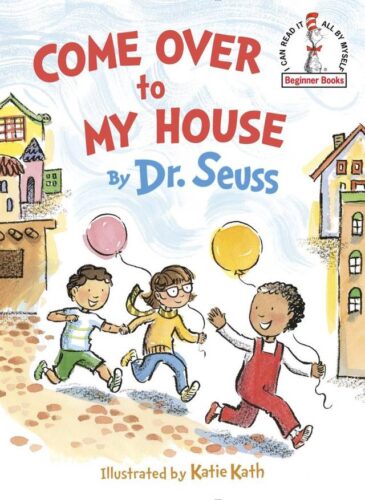
Originally published in 1966, I knew that this recent Seuss re-illustration was bound to differ from the original. I was, however, very trepidatious. I’ve been burned by shockingly offensive Seuss books before (please see: Surprise! It’s Racist!) and with that late 60s pub date there was no guarantee that either Seuss nor the original illustrator (Richard Erdoes) were inclined to be kind. Yet when I picked it up and read through it, it was lovely. Far better than the It’s-a-Small-World vibe you get from the cover and title, the book has a hook (visiting houses around the world) and it works. Add in Katie Kath’s art, which bends over backwards to be on the up-and-up and you’ve got yourself a truly worth new Seuss on your shelves.
The Cookie Fiasco by Dan Santat and Mo Willems
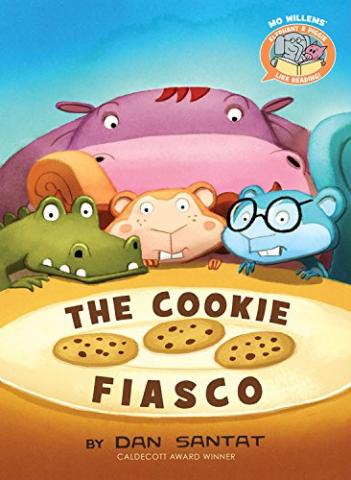
Pretty sure I’ve said everything there is to say about this book. There was a reason I put it on my math picture book list and if I could drown it in further laudatory comments I would do so. Eclectic, crazy original art, great characters, humor, math concepts, and a great storyline all combine.
Get a Hit, Mo! by David A. Adler

I loved loved loved Mo’s last book Don’t Throw It to Mo, which was a very rare easy book about football (children’s books about football at all are outnumbered by baseball books 10:1). And while this book covers the most written-about sport in literature for kids, I love it. It doesn’t hurt matters that my 2-year-old son also loves it (we live near Chicago and the Cubs won this year so . . .).
I See and See by Ted Lewin

The “I Like to Read” series by Holiday House has always frustrated librarians. We like the books a lot but because the publisher for some reason has always published the books at an egregious 8″ X 10″ (rather than the standard 6″ X 9″ where most easy readers fall) we tend to forget about them. They get shelved in the picture book sections and unless you know to spot their distinctive little spines, you’ll probably forget all about them. I couldn’t forget this book, though. Maybe it was the fact that it reminds me so much of NYC (I’m pretty sure he included the Bryant Park carousel at the end) but the very simple text and gorgeous Lewin art make for a winning combo.
Owl Sees Owl by Laura Godwin, ill. Rob Dunlavey

It’s not technically marketed as an easy reader, and indeed the text owes far more to the reverso poetry movement than anything else. That said, I was very taken with the quiet, contemplative little book. And I do think it’s sufficiently simple to enter onto this list. I do!
Snail and Worm: Three Stories About Two Friends by Tina Kügler
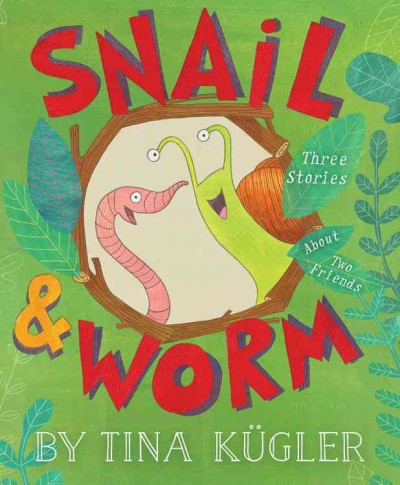
Oh. Oh oh oh. This is my #1 pick for the Geisel this year, no question. My five-year-old daughter has taken to reading one of these stories every morning to my two-year-old. As a result, anytime he sees a worm he will immediately say, “Worm! Worm! Where’s snail?” Where indeed. Deeply funny and original, these books are for kids who are working their way up to the Frog and Toad books. I’ve found it hard to come up with any easy readers that fall into this reading level quite so perfectly
Interested in the other lists of the month? Here’s the schedule so that you can keep checking back:
December 1 – Board Books
December 2 – Board Book Adaptations
December 3 – Nursery Rhymes
December 4 – Picture Book Readalouds
December 5 – Rhyming Picture Books
December 6 – Alphabet Books
December 7 – Funny Picture Books
December 8 – Calde-Nots
December 9 – Picture Book Reprints
December 10 – Math Picture Books
December 11 – Bilingual Books
December 12 – International Imports
December 13 – Books with a Message
December 14 – Fabulous Photography
December 15 – Fairy Tales / Folktales
December 16 – Oddest Books of the Year
December 17 – Older Picture Books
December 18 – Easy Books
December 19 – Early Chapter Books
December 20 – Graphic Novels
December 21 – Poetry
December 22 – Fictionalized Nonfiction
December 23 – American History
December 24 – Science & Nature Books
December 25 – Transcendent Holiday Titles
December 26 – Unique Biographies
December 27 – Nonfiction Picture Books
December 28 – Nonfiction Chapter Books
December 29 – Novel Reprints
December 30 – Novels
December 31 – Picture Books

 The Cookie Fiasco
The Cookie Fiasco
By Dan Santat
Additional Art by Mo Willems
Hyperion Books for Children (an imprint of Disney)
$9.99
ISBN: 978-1484726365
Ages 3-6
On shelves now
See, this is tricky. Very tricky indeed. On the one hand, as a reviewer of children’s books, not bound to any single periodical, I have the freedom to select any book I wish. As such, I like to highlight books that haven’t gotten a lot of attention. Imports, books from small presses, books that get lost in the ginormous publishing cycle each year, etc. It gives me a little kick. This isn’t to say I won’t review a bestseller, but what’s the point? The book gets lots of lovely money and doesn’t need my help. And though I absolutely adored the new easy book The Cookie Fiasco (part of the new Mo Willems “Elephant & Piggie Like Reading” series) I could see it sitting deservedly on the top of the New York Times bestseller list, as is right. A job well done then? Not quite. I made the mistake of reading some of the professional reviews of this book. Reviews that clearly had it in for this title from the start and failed to take into account what Dan Santat has managed to pull off here. It’s not just the art (which is far more complex than an initial reading yields). It’s not just the fact that it’s a brilliant story told in an easy book format with limited words. It’s not just the fact that it’s also a story about MATH (and why is it that no one is complimenting this book enough on that score?). It’s the fact that all these elements are combined together to make what I can honestly say is one of the best books of the year. Clever, funny, beautiful to look at, and an easy book that is actually easy (not a given), don’t pooh-pooh this one for its popularity. Take a moment instead to savor what Santat’s accomplished here. I like reviewing the underdogs, but sometimes the top dog IS the underdog. To prove it, I give you Example A: The Cookie Fiasco.
Three friends. Four cookies. It’s a conundrum, to say the least. When two squirrels, a hippo, and a crocodile find themselves with an insufficient number of snacks they attempt to solve the problem in a number of different ways. Perhaps someone will not get a cookie? Impossible! “We need equal cookies for all!” Could two people share one cookie together? Unfair idea. Do crocodiles actually like cookies? They do. Should they share by size? Unfair when you’ve a hippo for a friend. As the tension increases, the hippo finds the best way to relieve stress is to break the cookies into halves. Next thing you know there are twelve pieces. That means each person gets three apiece! Problem solved! Now about those three glasses of milk . . .
How would you definite a fiasco? In one of my favorite episodes of This American Life (titled, appropriately enough, “Fiasco!”) they defined the word as, “when something simple and small turns horribly large”. I don’t think you can truly appreciate this concept unless you have children. No one quite like a small, young person can take a basic idea like, say, eating banana slices rather than a whole banana before bed, and turn it into WWIII, complete with tears, mess, unearthly cries, and parents that vow they will never slice another banana again as long the world does turn. Children begat chaos and, as such, children LOVE controlled chaos. The kind of chaos that ultimately gets cleaned up by grown-ups in the end. Recently I’ve been noticing how it’s used in books more and more. Whether it’s the aquatic antics of Curious George Gets a Medal, the joyous free-for-all of I Ain’t Gonna Paint No More or what I consider to be the most absolutely insane, grotesque, explosion of the id upon the page, A Day at the Firehouse by Richard Scarry (seriously, you have to check it out), I love me a good jaunt through the wild side. Santat taps into this snowball effect all too well. The “fiasco” of this book sounds tame (the gentle breaking apart of the cookies) but like my 2-year-old son, the characters in this book react as if the hippo were snapping the very tendons of their limbs. It’s a gentle reminder that for kids, sometimes the greatest fiasco comes in bite-sized pieces.
Let it never be said that I am a librarian that cares about leveling. Lexile, Fountas and Pinnell, you name it, it’s not my cup of tea. As a public librarian I don’t really have to care, though. That’s my prerogative. Now I will freely admit that for an easy book The Cookie Fiasco has some slightly more complex words. Heck, the word “fiasco” is even in the title. That said, I really and truly believe that Santat did a stand up and cheer job with keeping the text on the simple side. My five-year-old is currently learning to read and doesn’t have an overt amount of difficulty getting through this text. Extra Added Bonus: The overly dramatic moments allow her to rage against the heavens with drama inflected voices. A nice plus.
You don’t need to teach your five-year-old fractions, you know. You’re not going to fail the Parent of the Year awards if you prefer to wait until the kid is a little older to bring them up. It’s fine. But by the same token, there’s nothing out there saying that you can’t be sneaky about them. The fact that the solution to everyone’s problems is fraction-based is notable. I try to read as many math books for kids published in a given year as possible and let me tell you, it’s not easy to find them. The thing about The Cookie Fiasco, though, is that it’s not promoting itself as a math book in any way, shape, or form. Santat just works it oh-so-casually into the text so that by the time you stumble upon it you’re caught off-guard. And hey, if you happen to mention that these are fractions to a kid, and then show what you mean with some additional information . . . well, that’s just your prerogative, isn’t it? Clever parent.
So I’m talking to a friend the other day and the subject of this book comes up. “Do you think it could be a Caldecott winner?” they asked me. I was stunned. Under normal circumstances easy books do not win Caldecotts. It’s not unheard of for them to garner awards above and beyond the Geisel (see: Frog and Toad Together which won a Newbery) but nobody usually puts enough work into the art of an easy book to even start the discussion. Yet after my friend mentioned this possibility to me, I began to remember what Santat did with The Cookie Fiasco. A sane man would have just slapped together some pictures, grabbed his paycheck, and skedaddled. Santat, on the other hand, went a little crazy. He decided that the wisest course of action was to create teeny tiny multi-colored models of the heads of all his characters. That way, when they imagine different solutions to their cookie problem, the heads will indicate that this an idea and not what’s actually happening. Now look closely at those models. Even when they look simple, Santat’s obviously been thinking about them. For example, when the hippo suggests that the squirrels share a cookie together, the accompanying model is of a single squirrel body with a heads of the two characters attached. Did you notice that the heads are red and blue but that the body is purple? Love that attention to detail there. I also started paying attention to repetition in facial expressions. Insofar as I can tell, Dan never has the exact same facial expression on a character appear on its model version twice in a row. Either the mouth is slightly open or the eyes are looking in a different direction. Remarkable.
And now, an ode to good speech balloons. It is not a commonly known fact, but speech balloons can make or break a book. Done poorly, as they often are, they make good books bad. They draw attention to themselves and not to the action on the page. You might think that since Santat is constantly mucking with the font sizes and sometimes the fonts themselves in this book, that is a bad thing. You would be wrong. The placement of these speech balloons is superb. There is never a moment a parent, whether or not they’ve ever read a speech balloon a day in their life, will get confused about the order of who speaks when. Which, when you think about it, really is a speech balloon’s sole job anyway.
Finally . . . what I didn’t like about the book: The female squirrel’s ponytails. Seemed superfluous. They come right out. That’s about it.
As I mentioned before, book doesn’t need me to review it. It’s been on the New York Times bestseller list and will certainly garner a Geisel Award if there is any justice in the universe. It has sold mad bank and will continue to sell well into the future. That said, I feel a need to defend its honor. This isn’t some random title in a popular series. If it came out without the name “Mo Willems” anywhere in sight I bet it would STILL be a massive hit. It has humor and fractions and killer art, and all sorts of things going for it. I review very few easy books, and even fewer popular easy books, in a given year, but I can always make exceptions. And this book, put plainly, is exceptional. Top notch stuff all around.
On shelves now.
Source: Galley sent from publisher for review.

A patron walks up to your children’s reference desk. Asks for books for beginning readers. The patron has a small child who is just at the very very beginning of learning to read and needs books with simple words. No big long sentences. Nothing too intense. Just the basics. You walk over to your easy section and look at the titles. And that’s when it hits you . . . easy easy? Basic books? Is there anything harder in the world to find sometimes?
I mention this because there’s been a lot of discussion amongst my fellows concerning the most basic readers. I’m talking books that come before you get to The Cat in the Hat. I remember with crystal clear clarity how I would have to turn time and again to the Berenstain book Old Hat, New Hat or other equally useful, equally old books. Where were the really really basic easy books out there that are currently being published? The advent of the Geisel Award for books for beginning readers is a marvelous place to go to try to find such books but even they trend a bit older.
The real problem here is that there’s no consistency between publisher reading level ratings. What might be a “3″ to one publisher is a straightforward “2″ to another. But having your books Lexiled (is that a verb) or otherwise leveled costs publishers money. Money they might not have if they’re a small operation. As a result, leveling often profits the big guys able to produce the cash upfront.
Now there are two series that meet the needs of the very very early reader. They don’t get a lot of attention or press but I figure they’re worth mentioning.
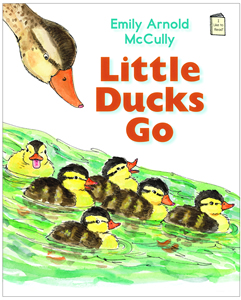 First off, there’s the Holiday House series “I Like to Read“. When looking for very very basic beginning reader books, this series has a lot to offer. First off, they get glorious artists like the Lewins or Emily Arnold McCully or David McPhail to provide the art. Then you’ve incredibly simple wordplay. On the back of each book is the leveling information too, just in case you’ve a patron insisting on such a thing. Their sole drawback? The size. To show off the art properly the books are the size of your average picture book (8″ X 10″). But if your library is anything like mine, the easy reader section contains only books, and consequently shelving, around 9″ X 6″ or so. And as much as you’d like to shelve this series with the other easy books, logistically it just doesn’t work. So you end up putting them in the picture book area, where they get lost amongst the more lengthy texts. If a librarian knows to recognize their singular blue spines then it isn’t a problem. However, until some are released in the standard easy reader format (something I hope for) they’ll never quite become as well known as they deserve to be.
First off, there’s the Holiday House series “I Like to Read“. When looking for very very basic beginning reader books, this series has a lot to offer. First off, they get glorious artists like the Lewins or Emily Arnold McCully or David McPhail to provide the art. Then you’ve incredibly simple wordplay. On the back of each book is the leveling information too, just in case you’ve a patron insisting on such a thing. Their sole drawback? The size. To show off the art properly the books are the size of your average picture book (8″ X 10″). But if your library is anything like mine, the easy reader section contains only books, and consequently shelving, around 9″ X 6″ or so. And as much as you’d like to shelve this series with the other easy books, logistically it just doesn’t work. So you end up putting them in the picture book area, where they get lost amongst the more lengthy texts. If a librarian knows to recognize their singular blue spines then it isn’t a problem. However, until some are released in the standard easy reader format (something I hope for) they’ll never quite become as well known as they deserve to be.
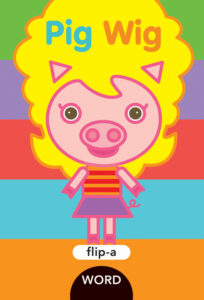 The other series I like is the Blue Apple Press books Flip-a-Word series. These books take very simple words and combine them in multiple ways, drilling them home. They’re akin to phonics without actually being phonics. Initially when I purchased them I put them in the picture book section but my librarians objected vociferously and we realized that they could do a lot more good in the easy reader section (they’re the right size anyway). Though they didn’t get any reviews initially, after perusing the titles I can attest that they’re well done. Smart writing, smart ideas.
The other series I like is the Blue Apple Press books Flip-a-Word series. These books take very simple words and combine them in multiple ways, drilling them home. They’re akin to phonics without actually being phonics. Initially when I purchased them I put them in the picture book section but my librarians objected vociferously and we realized that they could do a lot more good in the easy reader section (they’re the right size anyway). Though they didn’t get any reviews initially, after perusing the titles I can attest that they’re well done. Smart writing, smart ideas.
So what are the other really really basic series you know of?

 I first came up with the idea for a 31 Days, 31 Lists series in late September. Having kept track of a number of books over the year, it made a logical kind of sense. But as we got closer to the actual lists I realized that in some categories I’m going to be seriously lacking. Not having planned to do this series earlier in the year, I neglected certain areas.
I first came up with the idea for a 31 Days, 31 Lists series in late September. Having kept track of a number of books over the year, it made a logical kind of sense. But as we got closer to the actual lists I realized that in some categories I’m going to be seriously lacking. Not having planned to do this series earlier in the year, I neglected certain areas.










I loved the beauty and simplicity of Owl Sees Owl–very lovely! Thanks for reminding me about Snail & Worm–have to get to that one! Loved In Mary’s Garden!